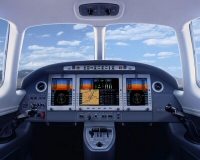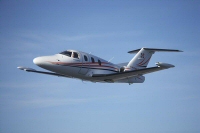| Flying the Eclipse | |
| | Flying by Looking at: Glass, Gauges, and Out the Window |
| | Integration: The Big Picture |
Flying the Eclipse
Flight Directors to Trend Monitors
BY DAN McELROY
I have about 6,000 hours in the Boeing B-727. It can be a very humbling airplane for the pilot. When I was learning to fly this airplane, I caused many rows of oxygen masks to snow down on my passengers at touchdown. These were the days before trend-vector displays in the cockpit.
When I learned to fly in the United States Air Force, it was in a T-37, which had hundreds of things to monitor and crosscheck. Then I transitioned to the T-38 and it had a bank-angle flight director. Wow, did this make things easier! A bar in the attitude indicator told me when to roll in and out of a turn to go to the heading or course I wanted.
The Lockheed C-141 also had pitch information in its flight director. The big problem with the C-141 was that different manufacturers got the contracts for the autopilot and flight-director systems and their designers forgot to talk to each other; each system "commanded" different bank angles to do the same thing. There were times when the autopilot was rolling in or out of a bank and the flight director was telling the pilot to do the opposite. Air Force pilots had to learn to live with it. Not quite the systems integration we expect today.
The McDonnell Douglas MD-88 had flight directors with pitch and roll, and the autopilot had altitude pre-select, and things got pretty good. Then the B-777 came along. It has trend monitors.
Gauges tell you what you are seeing - right now. Flight directors tell you what you need to do to get where you want, but trend monitors tell you what the airplane will be doing so many seconds from now based on the way it is currently being flown. I would love this option in the stock market!

What will the airplane be doing in 10 seconds? If I keep this bank and leave myself time to roll out, what will my new heading be? If I leave the throttles here, what will my power be when the engines finish spooling up? If I maintain this pitch attitude, configuration, and power setting, where will my airspeed be in 10 seconds?
At 500 feet before level off, the altitude command box changes color to warn you. At level off it changes again to let you know you have arrived. Your FMS knows the transition altitude for the country you are flying in and your barometric altimeter setting window changes color to warn you that you are nearing transition altitude.
All of these things seem so simple and are helpful and Eclipse finally did it. This is the total integration I was looking for when I got my first ride in the Eclipse 500; the airplane has all this and more. This is what is not possible with an airplane designed with generic off-the-shelf boxes.

This kind of integration would really have helped the B-727 pilots. The B-727 main gear is behind the center of rotation of the fuselage in the flare. The lift-over-drag curve in this configuration is flat and increasing pitch attitude in the flare does not always arrest the sink rate and 30 percent of lift, on final, is a thrust vector meaning power can not be reduced expecting to float. This all means that you not only had to be "on airspeed" but also "on power" with energy management in the envelope. At least this is the technical babble I would hide behind while trying to explain my arrival to the passengers on the B-727.
The six landings our family did in our Eclipse 500 test flight were all nice, and this is partially because of the trend monitors.
Posted Thursday, April 27, 2006 12:11:17 PM


